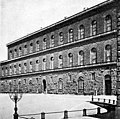Basement

The Bosse (from Middle High German bozen for 'to beat') is the protruding material of a natural stone inside a wall in the construction industry . The production of the cuboids is called embossing in the processing of natural stone surfaces.
In most of all cases you leave the bosses standing with a natural stone wall. Bosswork or rustica (from Latin rural ) is masonry made of stone blocks, the front side of which is only roughly hewn (embossed). In high medieval castle construction , where the bosses are often provided with an edge , an evenly worked edge all around, these stones are called humpback cubes .
A rare special case is the unplanned whereabouts of individual bosses within an otherwise processed natural stone facade: Ornaments and reliefs were often only worked out after the stone blocks had been moved, which is why sufficiently large, only roughly hewn blocks were used in the appropriate place. Sometimes, however, the completion did not take place, for example because the construction work was stopped altogether or the commissioned artist was no longer available.
Variants of masonry embossing
The bosses originally served to prevent heavy stones from sliding off the lifting ropes and is already used in ancient wall technology and on old American buildings.
There are different types of studs. With humpback blocks, a smooth edge is put around the bosses. If the bosses are smoothed out, one speaks of pillow blocks or upholstered blocks . A facet-like, pyramid-shaped front end have diamond square . In other cases, the bosses on the finished wall are deliberately knocked off and facetted masonry is obtained.
All forms are also reproduced in plaster masonry.
- Embossing
Wall corner of
La Tur CastleWall corner of Cagliatscha
Castle
Historical development
Bosswork was used in the architecture of antiquity as well as in medieval castle construction, and bossed masonry is often found on castles from the Staufer period . As a stylistic device, it was again widely used from the early Renaissance to the Baroque , especially for the representative, defensive design of the ground floor facades of palaces and castles .
The Mannerist style with its emphatically coarsely hewn, large cuboids and, in some cases, also embossed columns, enjoyed particular popularity . In some Mannerist palazzi, the rustication was also simulated by irregularly plastered brickwork . This type of wall structure is also known as rustication .
The embossing was also taken up again for the historicism of the Wilhelminian era , such as the Viennese Ringstrasse style , as a characteristic plaster imitation.
- Basement
Upholstery rustics. Florence, Strozzi Palace
Colossal pilaster with diamond stone blocks. Catania , University
Boss masonry at the Pitti Palace in Florence
Bosswork at the corners of the wall and for structuring the facade. Wiehlhaus , Slaný (Schlan), Central Bohemian Region , Czech Republic
literature
- Thanassis E. Kalpaxis: Hemiteles. Accidental incomplete and “boss style” in Greek architecture. Mainz 1986.







